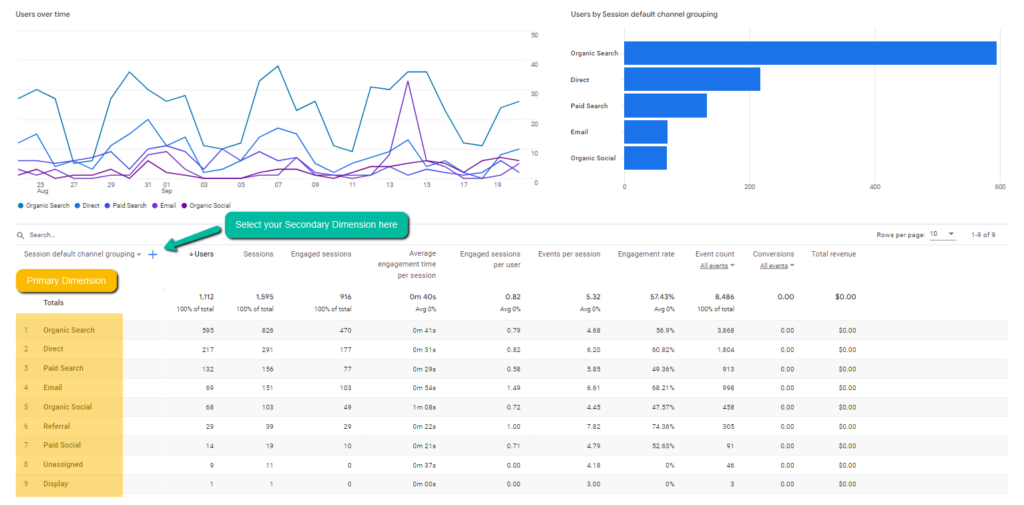Comprehensive Insights Using Secondary Dimension in Google Analytics
Comprehensive Insights Using Secondary Dimension in Google Analytics
Blog Article
Unlock Deeper Insights With Second Dimension in Google Analytics
With the substantial area of information available in Google Analytics, the use of additional dimensions can substantially enhance your logical capabilities. By tactically integrating second measurements into your evaluation, you can uncover important understandings that may or else remain obscure - Secondary Dimension in Google Analytics.
Understanding Primary Vs. Secondary Measurements
When analyzing data in Google Analytics, it is important to compare main and second dimensions to get deeper understandings into customer actions. Primary measurements are the major classifications through which you can see your data, such as source/medium, touchdown, or gadget web page. These measurements offer the fundamental framework for arranging and recognizing your information. On the other hand, secondary measurements allow you to more dissect your main measurement data. By including a second dimension, you can layer on additional info to your main measurement, making it possible for an extra granular analysis. For instance, if your primary dimension is the source/medium where customers got here on your website, including an additional dimension like geographic place can expose where those users are located geographically. This added layer of details can assist you determine trends, patterns, or anomalies that might not have actually appeared when considering the primary dimension alone. Leveraging both additional and primary measurements in Google Analytics is vital for thorough information analysis and informed decision-making.
Using Additional Dimensions Successfully
By incorporating second dimensions alongside key dimensions, analysts and marketing experts can dig much deeper right into the specifics of user communications on their web sites. Additional dimensions enable users to sector and filter main dimension data additionally, using a much more in-depth sight of customer demographics, interactions, and behaviors.
Furthermore, additional measurements make it possible for customers to contrast and contrast different data factors within a single report, facilitating an extra extensive evaluation of user habits patterns. By leveraging second dimensions properly, organizations can discover hidden insights, optimize their advertising and marketing approaches, and improve the general user experience on their internet sites.
Checking Out Typical Additional Dimension Combinations
To better analyze user behavior and trends in Google Analytics, it is useful to discover common mixes of additional measurements. Some common secondary dimension mixes that give beneficial understandings include evaluating web traffic sources with individual places to recognize where web site visitors are coming from geographically and just how they found the website. Taking a look at user habits metrics with second dimensions such as demographics or rate of interests can help in targeting particular audience sectors a lot more effectively.
Applying Additional Dimension in Customized Information
Making use of secondary dimensions in custom reports permits a more comprehensive analysis of information in Google Analytics, boosting the depth of insights gotten. When developing custom reports in Google Analytics, integrating second dimensions can offer a much more thorough view of exactly how various dimensions communicate with each various other. This feature allows users to delve much deeper right into their data and uncover important relationships that may not be instantly noticeable.
By applying secondary dimensions in custom reports, users can gain a much better understanding of their website or app website traffic. As an example, incorporating the key measurement of "source/medium" with the secondary dimension of "touchdown page" can disclose which touchdown pages are executing finest for web traffic coming from details sources. This understanding can help marketers enhance their campaigns and enhance general conversion rates.

Enhancing Information Visualization With Additional Measurement
When exploring information in Google Analytics custom records, incorporating secondary measurements not only provides a more detailed analysis however additionally improves the graph of understandings through information visualization. By adding a secondary dimension to your records, you can enrich the means information is offered, making it much easier to recognize patterns, fads, and relationships within your site's efficiency metrics.
Additional measurements can help you segment your data additionally, permitting a deeper understanding of individual behavior and communications on your website. When attempting to separate certain variables that might affect your internet site's efficiency., this improved level of granularity can be specifically useful.

Conclusion
To conclude, leveraging second dimensions in Google Analytics enables an extra comprehensive evaluation of information, leading to deeper insights and even more enlightened decision-making. Secondary Dimension in Google Analytics. By adding extra layers of details to main information sets, analysts and marketers can uncover surprise trends, patterns, and connections that give a granular sight of individual actions and interactions. This boosted level of understanding allows optimization of campaigns and tailored strategies for details audience segments, eventually improving performance and conversion prices
On the various other hand, secondary dimensions allow you to additional dissect your main dimension data. By including an additional dimension, you can layer on added info to your key dimension, making it possible for a more granular evaluation. If your main measurement is the source/medium with which users got here on your site, including an additional measurement like geographic location can reveal where those individuals are situated geographically. By incorporating additional dimensions along with primary measurements, marketing experts and experts can dig deeper into read the full info here the specifics of user communications on their sites. Additional measurements permit customers to sector and filter key dimension information additionally, supplying a my blog more comprehensive sight of user interactions, actions, and demographics.
Report this page